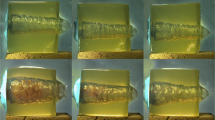Abstract
Since decades, 10% gelatine is used to visualize and estimate the energy transfer of projectiles. The study performed investigates the correlation of the temporary cavity (TC) recorded by high-speed video (HSV) and the cracks in gelatine slices. A total of 36 shots were performed from distance using form-stable bullets (FMJ), 12 using deforming bullets (HP) in the calibres .32 auto, .38 special and 9 mm Luger. The target models were prepared according to Fackler’s standard as 10% gelatine cubes with 12 cm edge length doped with a paint pad beneath the front cover (“reference cube”). Scaled images of the TC were recorded with 40.000 fps. The cubes were cut into 1-cm-thick gelatine cross sections, which were scanned. The evaluation of the destruction (cracks) was performed by the mean of image analysis measuring the longest crack, the wound profile according to Fackler and applying the polygon method. The height of the TC was measured each cm along the bullet path. The energy deposited ranged between 54 and 269 J. FMJ caused tubular, HP provoked pear-like TC. The tubular aspect was consistent with the quasi-constant deceleration of FMJ; however, the pear-like TC did not metrically represent the deceleration of HP. The profiles of destruction parameters were convex for both projectile types and did not match the profile of bullet deceleration. The maximum of TC stretching observed in HSV did not coincide with maximum gelatine destruction (crack lengths). The total energy transfer correlated with all considered destruction parameters in their sum; however, the cross-sectional parameters did not reflect the energy transfer per centimetre bullet path. The sum of the TC’s heights correlated with the energy deposited, but differently for FMJ and HP. Obviously, the 12-cm reference cube reflects the energy transfer by a bullet as a whole.









Similar content being viewed by others
References
Kneubuehl BP (2011) Simulants. In: Kneubuehl B (ed) Wound ballistics: basics and applications. Springer, Berlin Heidelberg, pp 136–143
Fackler ML, Surinchak JS, Malinowski JA, Bowen RE (1984) Bullet fragmentation: a major cause of tissue disruption. J Trauma 24(1):35–39
Fackler ML, Surinchak JS, Malinowski JA, Bowen RE (1984) Wounding potential of the Russian AK-74 assault rifle. J Trauma 24(3):263–266
Fackler ML, Malinowski JA (1988) Ordnance gelatin for ballistic studies. Detrimental effect of excess heat used in gelatin preparation. Am J Forensic Med Pathol 9(3):218–219
Jussila J (2004) Preparing ballistic gelatine—review and proposal for a standard method. Forensic Sci Int 141(2–3):91–98
Jussila J (2005) Measurement of kinetic energy dissipation with gelatine fissure formation with special reference to gelatine validation. Forensic Sci Int 150(1):53–62
Gawlick H, Knappworst J (1975) Zielballistische Untersuchungsmethoden an Jagdbüchsengeschossen, Ballistisches Laboratorium für Munition der Dynamit. Nobel AG, Werk Stadeln
Ragsdale BD, Josselson A (1988) Predicting temporary cavity size from radial fissure measurements in ordnance gelatin. J Trauma 28(1 Suppl):S5–S9
Fackler ML, Malinowski JA (1985) The wound profile: a visual method for quantifying gunshot wound components, J. Trauma 25(6):522–529
Schyma CW (2010) Colour contrast in ballistic gelatine. Forensic Sci Int 197(1-3):114–118
Schyma C, Madea B (2012) Evaluation of the temporary cavity in ordnance gelatine. Forensic Sci Int 214(1–3):82–87
Schyma C, Brünig J, Jackowski C, Müller R (2017) Messung der Geschossgeschwindigkeit mittels Hochgeschwindigkeitskamera. Rechtsmedizin 27:273–277. https://doi.org/10.1007/s00194-017-0180-z
Schyma C, Infanger C, Müller R, Bauer K, Brünig J (2019) The deceleration of bullets in gelatine - a study based on high-speed video analysis. Forensic Sci Int 296:85–90. https://doi.org/10.1016/j.forsciint.2019.01.017
Schyma C, Bauer K, Brünig J (2017) The reference cube: a new ballistic model to generate staining in firearm barrels. Forensic Sci Med Pathol 13(2):188–195. https://doi.org/10.1007/s12024-017-9868-3
Schyma C, Herr N, Brünig J, Brenčičová E, Müller R (2017) The influence of the counterfort while ballistic testing using gelatine blocks. Int J Legal Med 131(5):1325–1332. https://doi.org/10.1007/s00414-017-1623-5
Kneubuehl BP, Glardon MJ (2010) Polizeigeschosse und ihre Deformation, Abhängigkeit von Geschwindigkeit und Schussdistanz. Rechtsmedizin 20:80–84. https://doi.org/10.1007/s00194-010-0658-4
Zhang J, Yoganandan N, Pintar FA, Guan Y, Gennarelli TA (2007) Experimental model for civilian ballistic brain injury biomechanics quantification. J Biomech 40(10):2341–2346
Schyma C (2012) Wounding capacity of muzzle-gas pressure. Int J Legal Med 126(3):371–376
Schyma C, Greschus S, Urbach H, Madea B (2012) Combined radio-colour contrast in the examination of ballistic head models. Int J Legal Med 126(4):607–613
Schyma C, Müller R, Brenčičová E, Brünig J (2018) Distortion of the temporary cavity and its influence on staining in firearm barrels. Forensic Sci Med Pathol 14(2):202–208. https://doi.org/10.1007/s12024-018-9971-0
Ragsdale BD, Josselson AR (1986) Winchester Silvertip® ammunition – a study in ordnance gelatin. J Forensic Sci 31(3):855–868
Lazarjan MS, Geoghegan PH, Jermy MC, Taylor M (2014) Experimental investigation of the mechanical properties of brain simulants used for cranial gunshot simulation. Forensic Sci Int 239:73–78
Falland-Cheung L, Waddell JN, Lazarjan MS, Jermy MC, Winter T, Tong D, Brunton PA (2017) Use of agar/glycerol and agar/glycerol/water as a translucent brain simulant for ballistic testing. J Mech Behav Biomed Mater 65:665–671. https://doi.org/10.1016/j.jmbbm.2016.09.034
Zhang L, Jackson WJ, Bentil SA (2019) The mechanical behavior of brain surrogates manufactured from silicone elastomers. J Mech Behav Biomed Mater 95:180–190. https://doi.org/10.1016/j.jmbbm.2019.04.005
Singh D, Boakye-Yiadom S, Cronin DS (2019) Comparison of porcine brain mechanical properties to potential tissue simulant materials in quasi-static and sinusoidal compression. J Biomech 92:84–91. https://doi.org/10.1016/j.jbiomech.2019.05.033
Author information
Authors and Affiliations
Corresponding author
Ethics declarations
Conflict of interest
The author declares that he has no conflict of interest.
Additional information
Publisher’s note
Springer Nature remains neutral with regard to jurisdictional claims in published maps and institutional affiliations.
Rights and permissions
About this article
Cite this article
Schyma, C.W.A. Ballistic gelatine—what we see and what we get. Int J Legal Med 134, 309–315 (2020). https://doi.org/10.1007/s00414-019-02177-z
Received:
Accepted:
Published:
Issue Date:
DOI: https://doi.org/10.1007/s00414-019-02177-z




